Unit II: humanities II Exam
1/81
There's no tags or description
Looks like no tags are added yet.
Name | Mastery | Learn | Test | Matching | Spaced |
|---|
No study sessions yet.
82 Terms
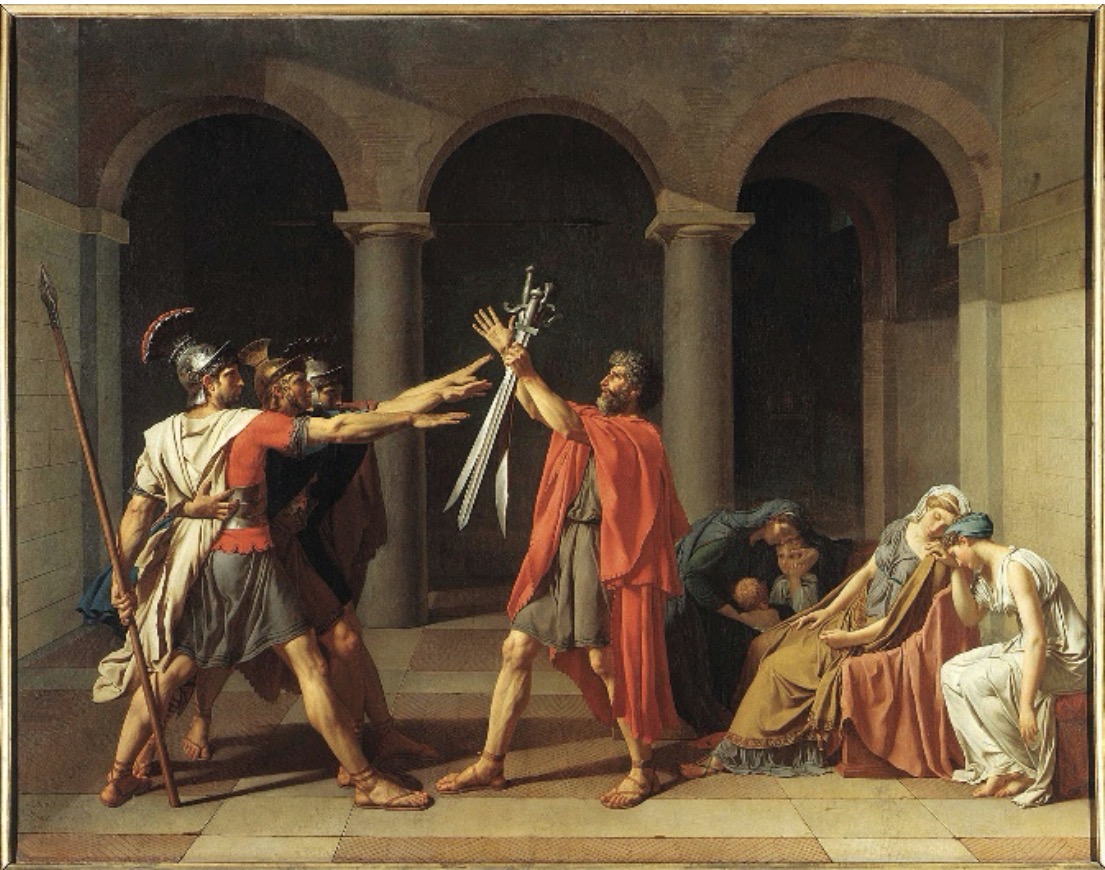
Title: The Oath of the Horatii
Artist: Jacques Louis David
Style/period: Neoclassical Period
Fact 1: This artwork was commissioned by the royal government to depict an example of loyal devotion to the state. This work does not depict a battle, but the moments prior. It depicts the three sons of Horatius swearing an oath to their father.
Fact 2: The sons on the left, the father in the middle, and the sisters on the left, line up with the archways depicted behind them. This detail creates a sense of separation between the three groups, which could represent their differing roles. However, it also creates a sense of unity that draws attention towards the middle of the painting, which could also represent the familial connection between the three groups
Fact 3: Unlike the other parts of the painting that breaks away from Baroque or classical period, the way David positioned the women is much like how they would have been portrayed during the Baroque or classical period. This represents an implied message that David hoped to share with viewers.
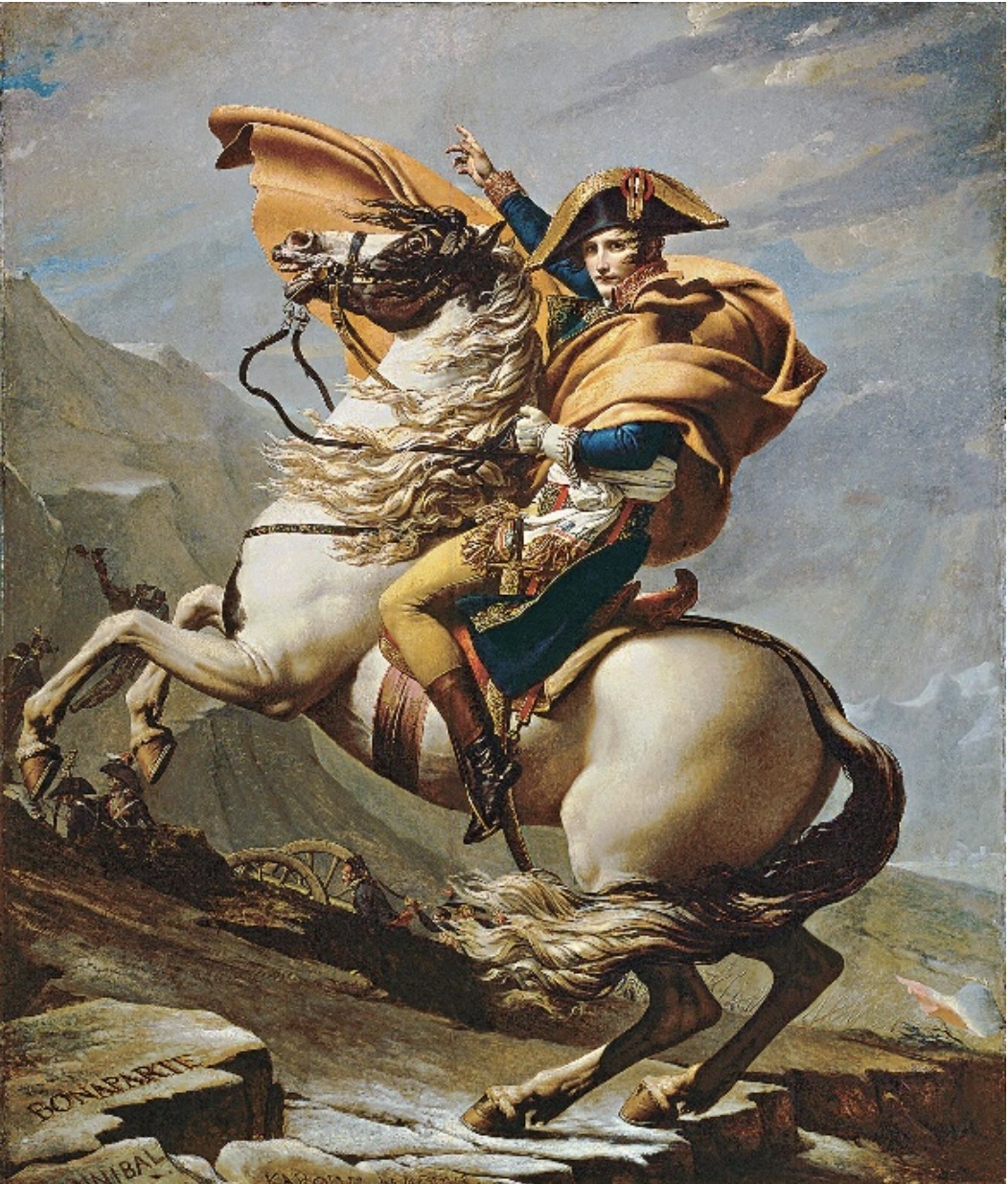
Title: Napoleon Crossing the Saint-Bernard
Artist: Jacques Louis David
Style/period: Neoclassical Period
Fact 1: This image depicts Napoleon on horseback leading his troops. However, it is just pure propaganda. Napoleon did not actually lead the crossing, but crossed it with his rearguard, while mounted on a mule led by a peasant.
Fact 2: There are five copies of this painting, all executed by David and his studio assistants. All of these paintings were executed in a fairly quick manner. Each one of these paintings was set to go to prominent buildings as gifts.
Fact 3: David employed the use of geographical principles, that ensure a clearly drawn central image. David placed great emphasis on right angles. Napoleons leg, his arm, the horses head and neck, and the horse rear legs all create right angles.
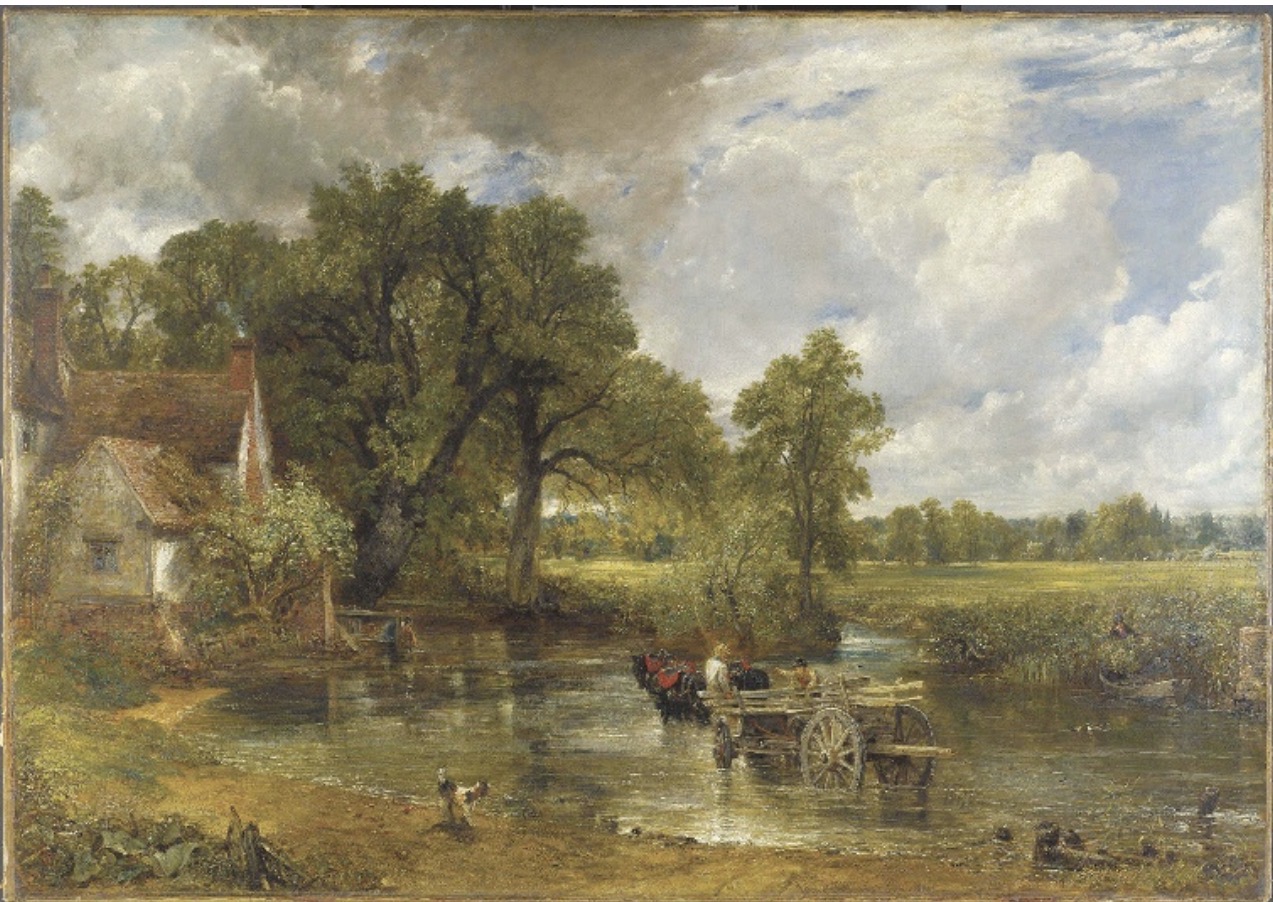
Title: The Hay Wain
Artist: John Constable
Style/period: Romanticism Period
Fact 1: This artwork was a part of a larger series. This was completed on a large canvas and was modeled after previous sketches and drawings he had done earlier. The title of the series is referred to as Constable’s “six-footers”.
Fact 2: The painting depicts sets of opposites. For starters, a passing storm is indicated by dark clouds on the left, but the right depicts a brightly lit field with billowing clouds. The tree with a massive trunk on the left contrasts with freshly cut hay on the right. The gentleman fisherman contrasts with the hardworking cart drivers.
Fact 3: Londoners who viewed the painting complained that the painting seemed unfinished because it was painting in an abstract way. Constable achieved this look through short, broken strokes of color in a variety of shades and hints to produce this hue, meaning, abstract, is how he wanted his painting to look.
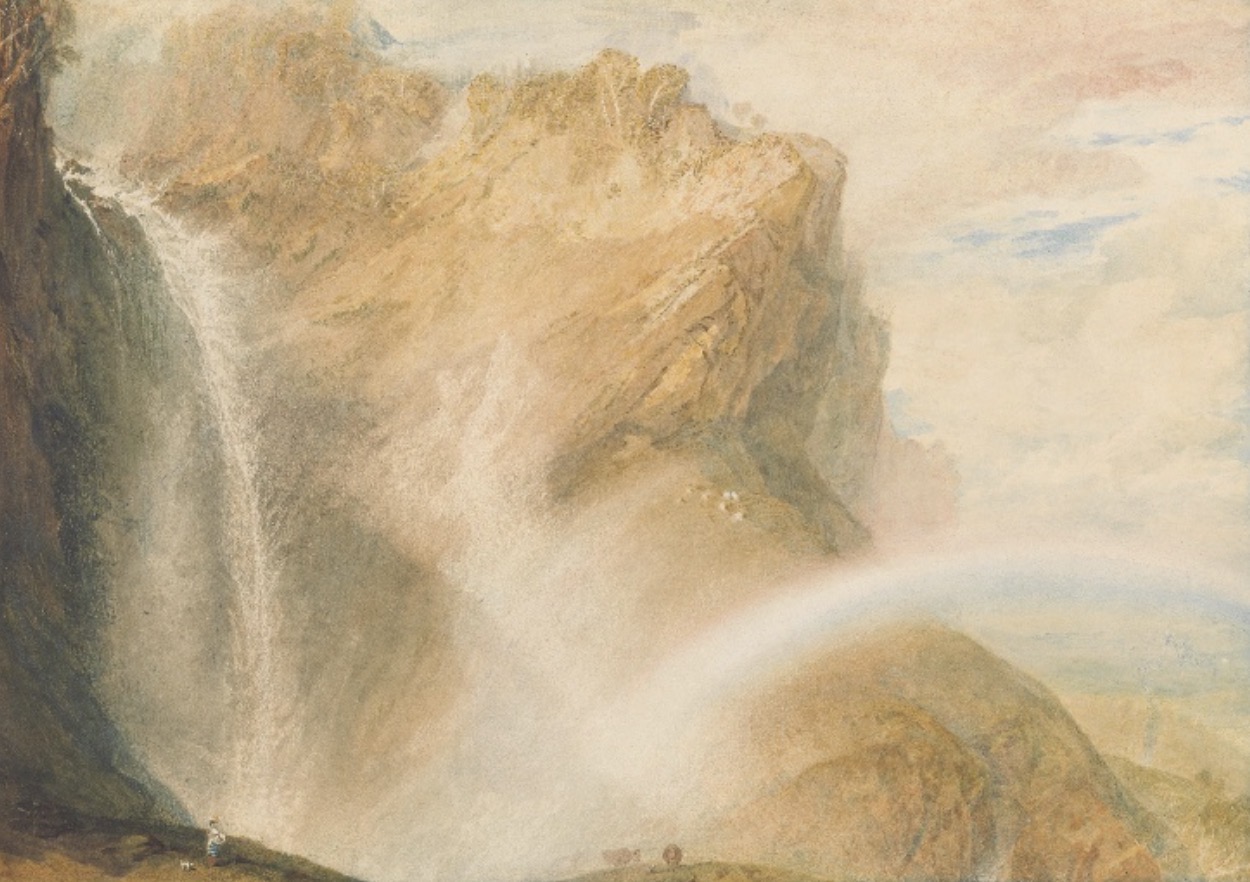
Title: The Upper Falls of the Reichenbach
Artist: J.M.W. Turner
Style/period: Romanticism Period
Fact 1: Turner was known as a great English landscape painter. He was known for focusing primarily on the medium in which objects in nature were seen, vs the object itself. This led to him focusing on what he called “the colors of the imagination.” For instance, he draws attention to the mist and light versus the rock, cliff, and mountain.
Fact 2: Turner seems to have painted this artwork in such a way that the falls seem to animate the rocky precipice. He painted the earth and vegetation in such a way that it seemed to dissolve into light and water.
Fact 3: Turner’s work is known for being exotic, depicting remote areas, and leading to feelings of alienation. Unlike other artists, like Constable, the human figures are a minuscule or irrelevant part of his paintings. Which some believe represents people’s minuteness in nature.
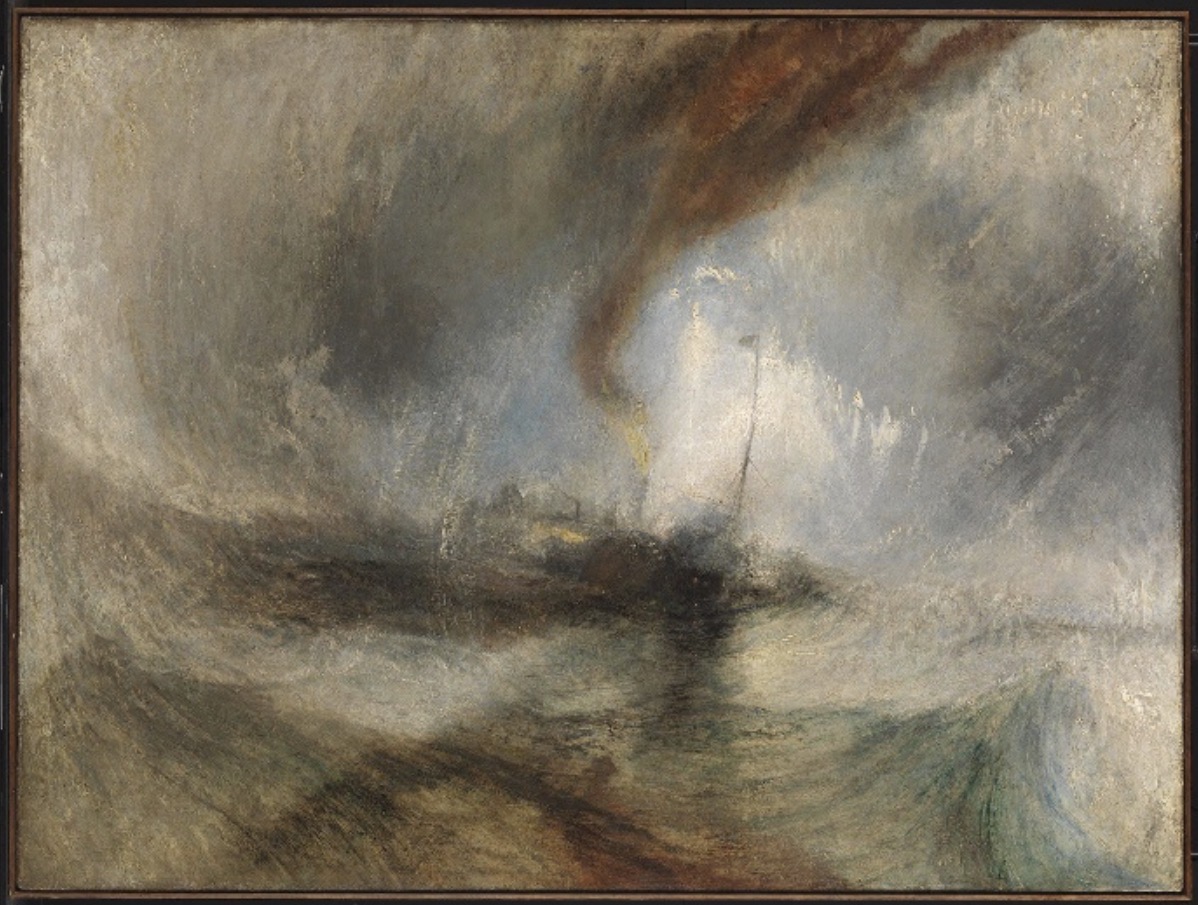
Title: Snow Storm/Steam Boat
Artist: J.M.W. Turner
Style/period: Romanticism Period
Fact 1: This painting suggests the “extinction” of the “hope of man”. This is a stark contrast compared to Constable’s landscape paintings or Wordsworth’s “natural piety”. Turner wanted viewers to immerse themselves in the primal forces of nature.
Fact 2: Although there is no evidence confirming a ship named Ariel, Turner claimed that he “got the sailors to lash me to the mast to observe it”, it referring to the storm. He did so in hopes of truly capturing atmosphere of the storm and the feelings it gives viewers
Fact 3: As viewers study this painting, they become entranced by the chaotic light and darkness, which is unlike the Enlightenment ideals of clarity, order, and harmony.
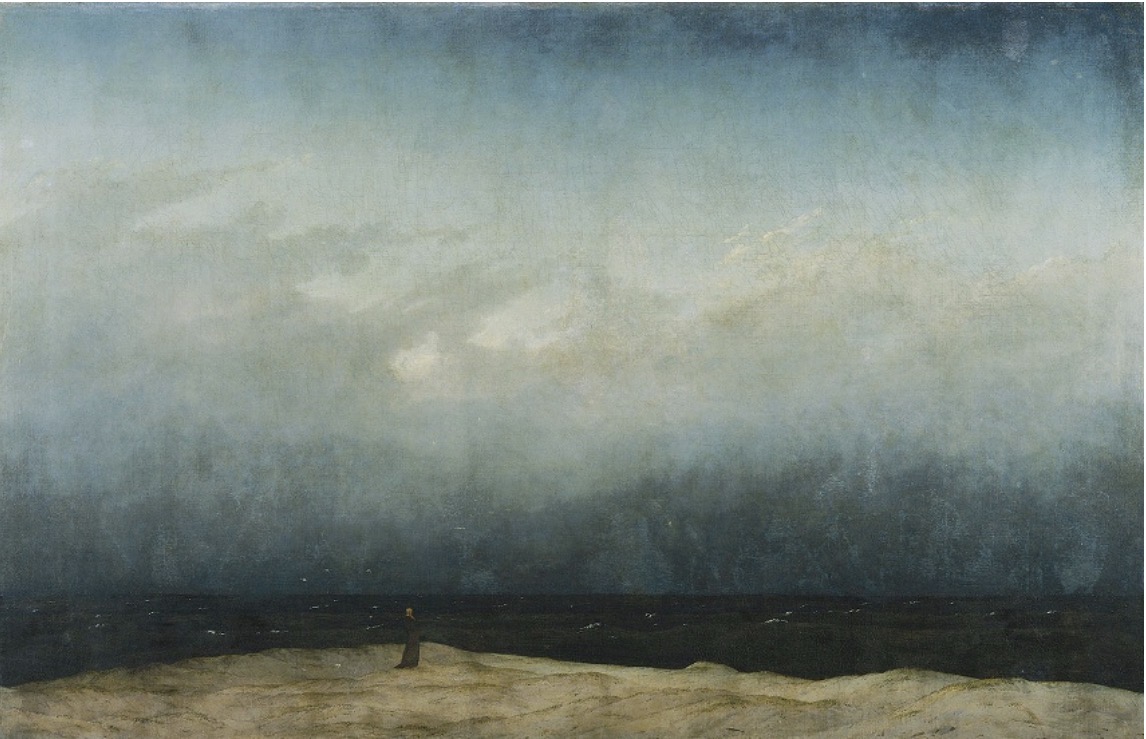
Title: Monk by the Sea
Artist: Caspar David Friedrich
Style period: Romanticism Period
Fact 1: It is important to think about the stylistic period when viewing this painting. This painting was created during the romanticism period. Imagination, which was an important tool for Friedrich, was a fundamental starting point in German Romantic tradition.
Fact 2: This artwork depicts a figure standing alone, surrounded by sand and storms, with no one and nothing around. This was meant to represent the spiritual crisis that the monk in the painting was facing.
Fact 3: Some art histories argue that this painting is a self-portrait of Caspar Friedrich. They make this claim based on the belief that the monk featured in the painting is Friedrich himself.
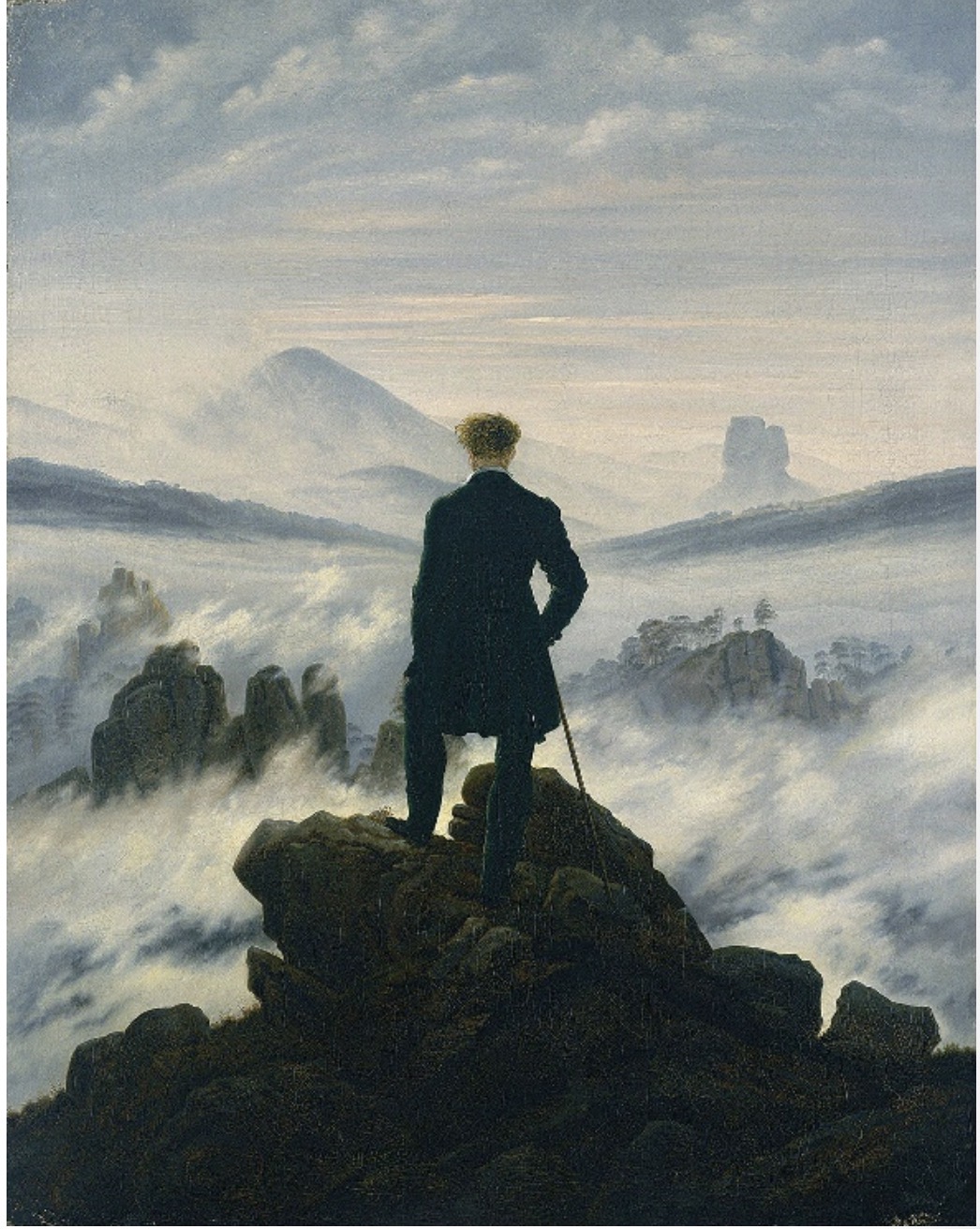
Title: The Wanderer above the Mists
Artist: Casper David Friedrich
Style/period: Romanticism Period
Fact 1: Friedrich’s paintings were often known for being centered around a theme of doubt, not to ensue anxiety, but to promote imagination. For instance, the rock blocking viewers view of what the man is seeing, makes people image what he is looking at.
Fact 2: However, in a deeper sense not only is the viewer’s view limited, but also the man’s. The man’s view is limited by the mist that has set in. The stimulation caused by the contrast between the near rock and the atmosphere further drives imagination.
Fact 3: The vast mountains, the ethereal atmosphere and the mist in the distant can also be symbolic of a relationship between earth and the spiritual world.
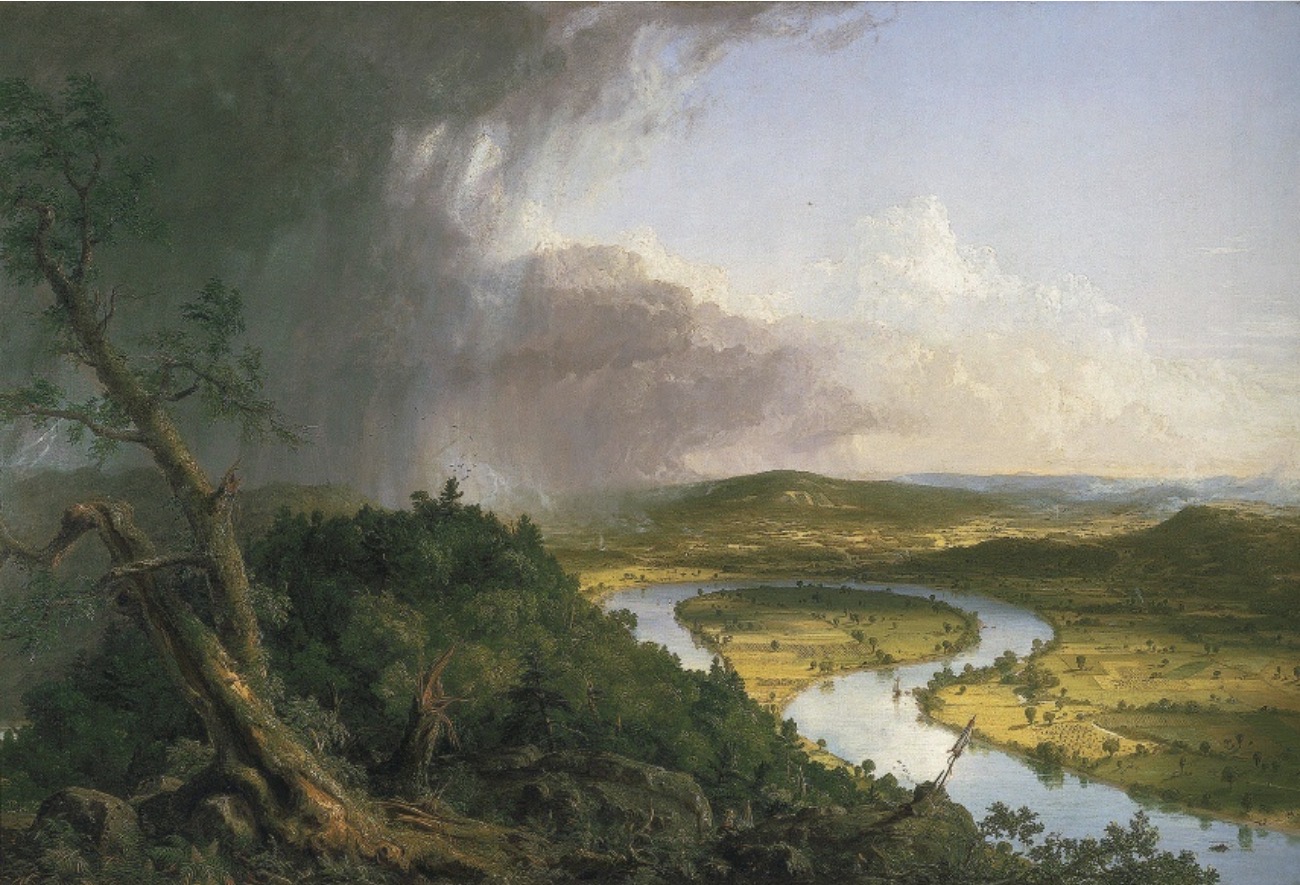
Title: The Oxbow
Artist: Thomas Cole
Style/period: Romanticism Period
Fact 1: This artwork is considered to be landscape painting. Thomas Cole, the artist, is known as the founding father of American landscape painting. He had the opportunity to view sites such as the one featured in the picture, after his family emigrated to America from England at around 18 years of age.
Fact 2: This painting depicts a famous bend in the Connecticut River and the wilderness of Mount Holyoke. It is an example of a tension he hoped to create by capturing “the improvements of cultivation and the sublimity of the wilderness”.
Fact 3: By painting himself in the scene, scholars describe Cole as a mediator between the sunny fields below him and rugged wilderness behind him marked by dark clouds and broken tree stumps. Scholars believe that this was done with the intention of portraying the idea that at some point the darkness will overcome the light.
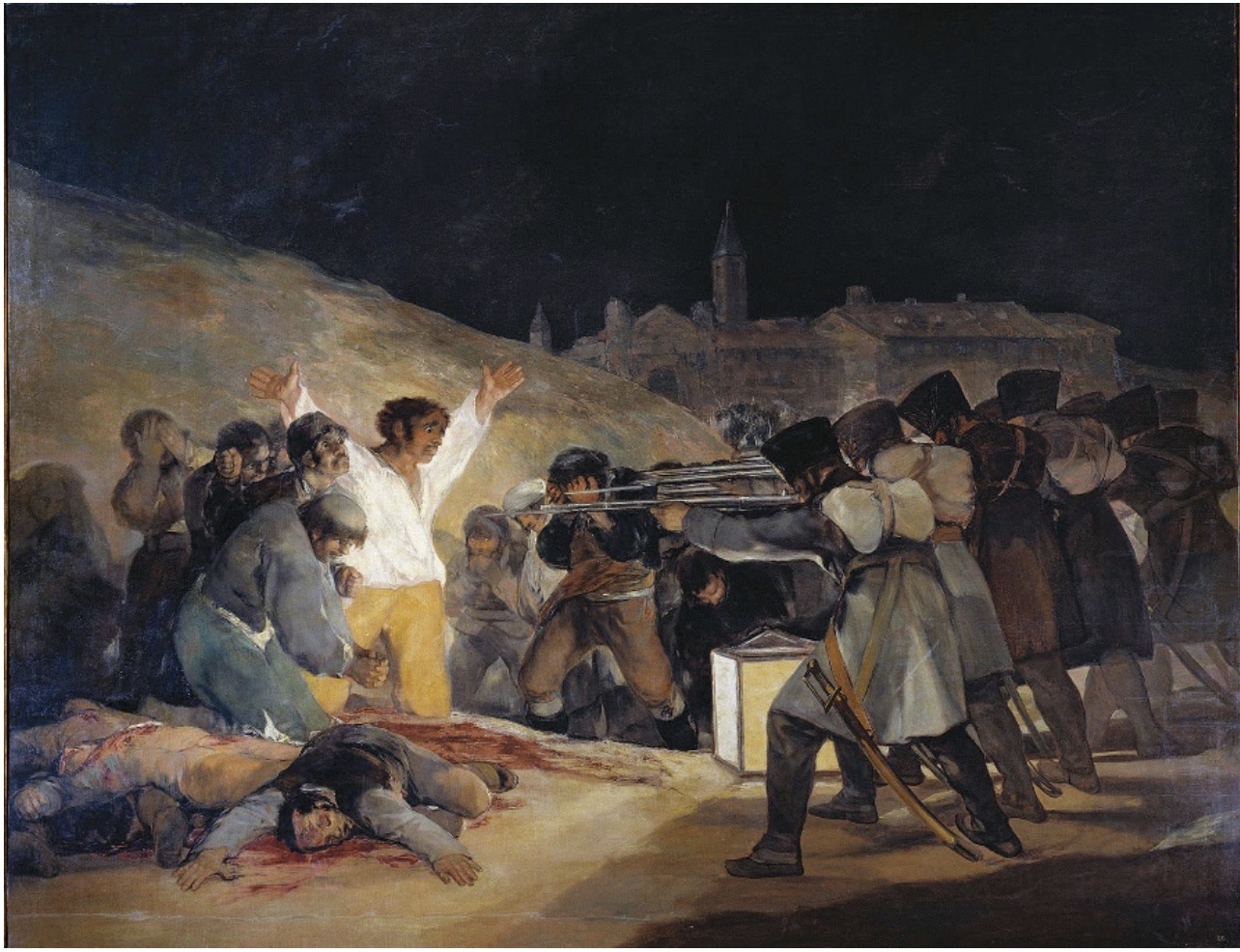
Title: The Third of May
Artist: Francisco Goya
Style/period: Romanticism Period
Fact 1: This picture was painted to commemorate the executions that took place on May 3, 1808. The men in the picture who have been executed or are facing execution are Madrid citizens who revolted against Napoleons troops on May 2, 1808.
Fact 2: Goya used light, much like in the Baroque period, to draw attention to the prisoner who seems to be caught in the midst of both a plea for mercy and an act of heroic defiance. The cruciform pose represents the agony that the men faced awaiting execution.
Fact 3: To the left, a frightened man awaiting execution is seen hiding in terror of what awaits him. Above the waiting men, is a darked church steeple that could represent a far-off sense of hope that has now faded. Which can also be connected to Goya’s belief that the world had abandoned reason.
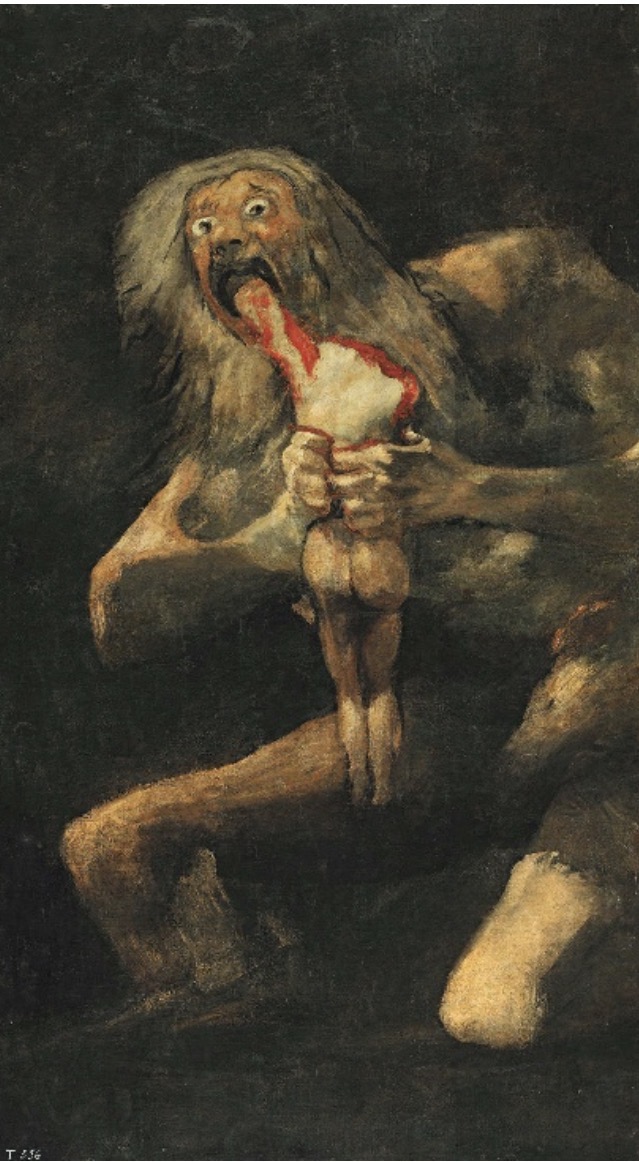
Title: Saturn Devouring One of His Children
Artist: Francisco Goya
Style/Period: Romanticism Period
Fact 1: This is a part of a set of q4 oil paintings known as the “black paintings”. These paintings were painted directly on the plaster of Goya’s house. Historians have found no record of written titles for these artworks or explanations of them.
Fact 2: This painting is based on the story of Kronos eating his children. This artwork is titled with the name Saturn instead of the name Kronos because Saturn is the Latin form of Kronos, which is in the Greek form. Latin was a much more common form of language during this time.
Fact 3: At Goya’s home, this painting faced the main door. This unwelcoming image can be connected to Goya’s push towards isolation in the end years of his life. The disturbing image of cannibalism can also be representative of Spain devouring its own people.
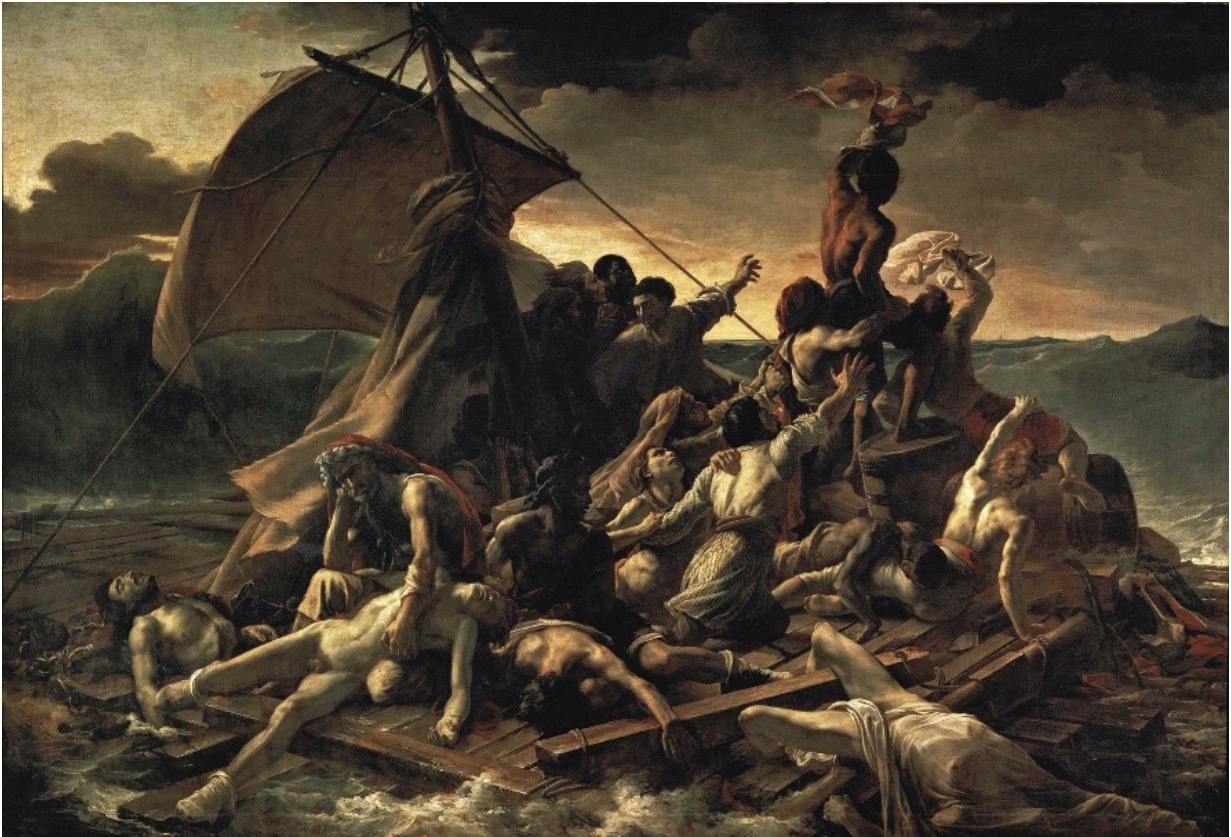
Title: The Raft of the Medusa
Artist: Theodore Gericault
Style/Period: Romanticism Period
Fact 1: The image depicts the aftermath of a government frigate, which was named medusa, that shipwrecked on a reef, while carrying soldiers and settlers. It depicts the cannibalism, mutualism, and thirst that the people faced after being left there by the captain and crew.
Fact 2: Gericault was outraged. He interviewed survivors and painted mutilated bodies in the Paris morgue in the hopes of bringing attention to the inexperienced captain, who was chosen because of his noble birth and connections, that saved himself. This was representative of the aristocratic privilege that not associated people, had to deal with.
Fact 3: The mast and two ropes form the apex of one triangle, and the torso waving represents the angle of a second triangle. The opposing diagonals formed by these triangles form an “X”. This can be representative of their hope for salvation and be tied to the geometric structure parodies of Neoclassicism.
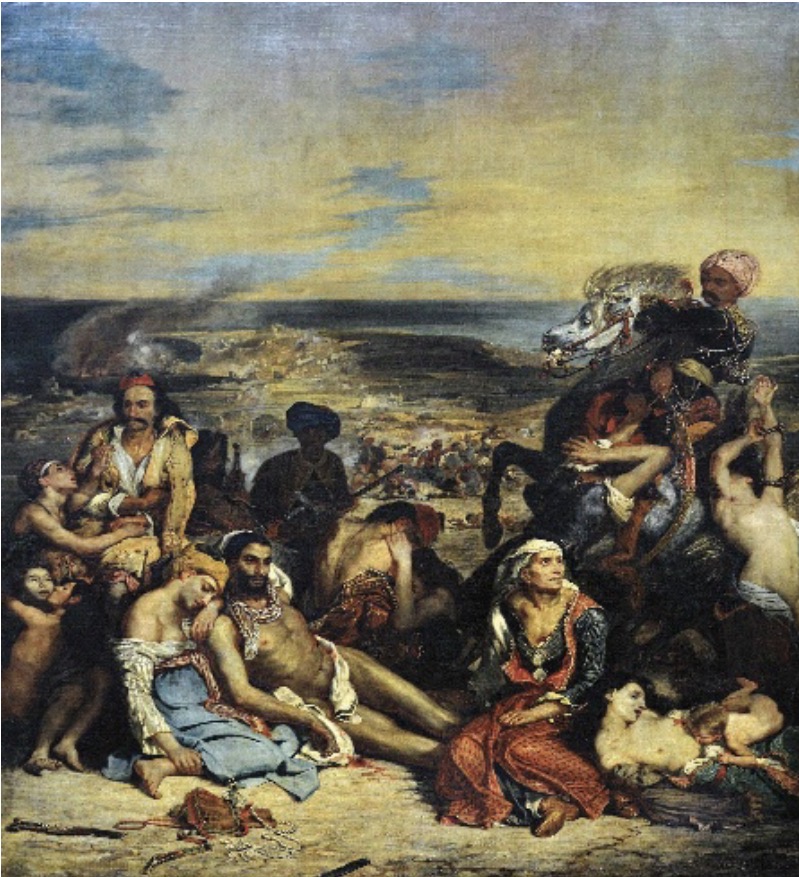
Title: Scenes from the Massacres at Chios
Artist: Eugene Delacroix
Style/Period: Romanticism Period
Fact 1: Delacroix was a young artist who studied with Theodore Gericault. These two artist shared disillusionment with royalistic politics. He painted this artwork during a time that was marked by the repression of art that seemed “dangerous” to political activity.
Fact 2: This artwork depicts the aftermath of the War of Independence from Turkey. It depicts the retaliation of the sultan to the Greeks. This artwork shows the devastation the Greeks experienced 20,000 people were killed and thousands of women and children were takin into captivity and sold into slavery.
Fact 3: In the foreground of the left side of the painting, the artist depicts several Greek families awaiting execution. To the right a child is seen trying to suckle its dead mother’s breasts and a prisoner tries to defend a Greek Woman. This scene can be compared to Goya’s The Third of May 1808.
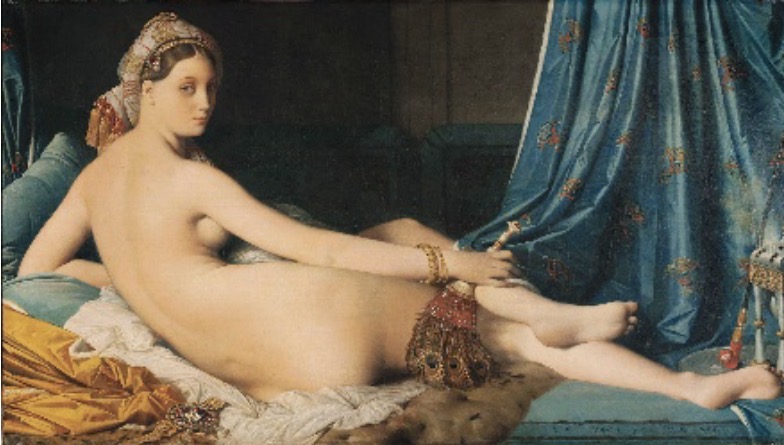
Title: La Grande Odalisque
Artist: Jean Auguste-Dominique Ingres
Style/Period: Romanticism Period
Fact 1: This artwork was commissioned by Caroline Murat, Queen of Naples. As the title clues, it depicts an odalisque which was the name given to a female slave or concubine in a Middle Eastern harem.
Fact 2: Viewers quickly realized the model was disproportioned. Ingres was not phased by this because his focus was more so centered around the demanding curve of the drapery.
Fact 3: Like many artists, Ingres used light to create contrasts and bring attention to objects in the artwork. For example, the skin of the odalique, the drapery, and the peacock fan all differ dramatically from the dark background of the image.
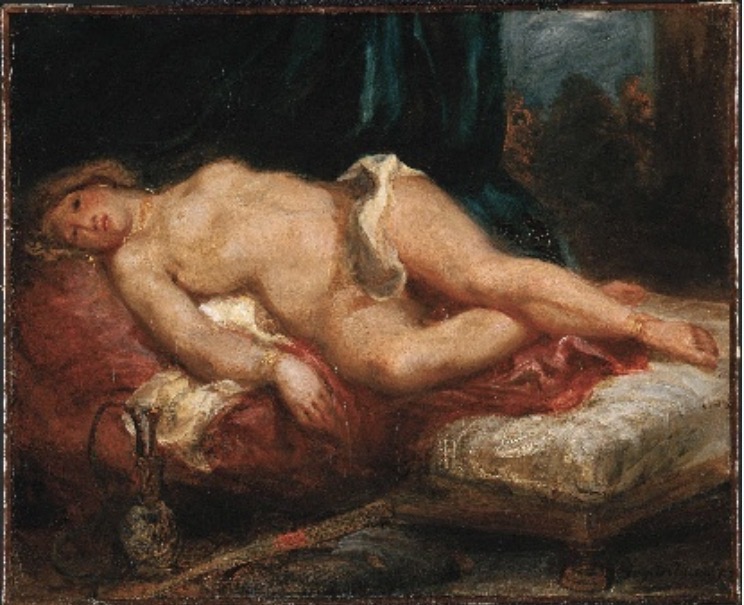
Title: Odalisque
Artist: Eugene Delacroix
Style/Period: Romanticism Period
Fact 1: Alongside Ingres, Delacroix also painted art featuring odalisque. Both of these artists’ works included curtained rooms, hashish pipe or a hookah, and an unkempt bed. All these things were associated with odalisques.
Fact 2: Delacroix used deep reds to create a sense of intense eroticism within his artwork, were as, Ingres’s painting used cool tones to create a sense of sexual aloofness.
Fact 3: Ingres focused on creating an artwork wherein brush strokes were almost not evident. Delacroix was known for artwork in which almost every brushstroke was evident. This created what he called “the fury of the brush”.
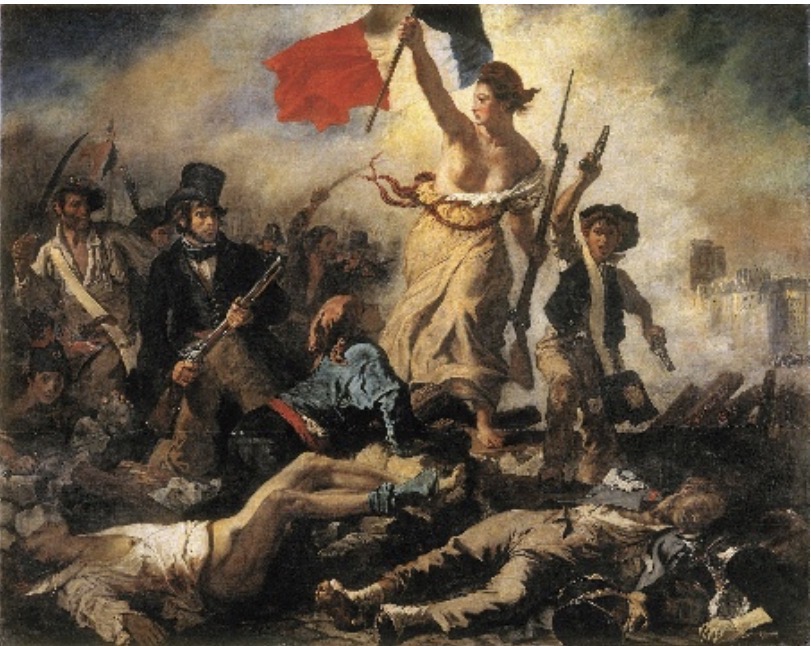
Title: Liberty Leading the People
Artist: Eugene Delacroix
Style/Period: Romanticism Period
Fact 1: Delacroix used his talents not only to express aesthetic taste but also to acknowledge political struggles. This artwork celebrates the revolution that erupted again after first starting in 1830.
Fact 2: This artwork contains a vital element, Lady liberty. She is depicted by a bare-breasted women meant to represent the nurturing power of freedom. She is seen stepping over a barricade, this could represent rebellion, risk, breaking boundaries, transformation or resolution.
Fact 3: This artwork uses a triangular structure composed of two French royalism guards. These two guards are seen stripped of their shoes or clothes and in a state of distress in a pose that is almost identical to that of Gericault’s Raft of the Medusa.
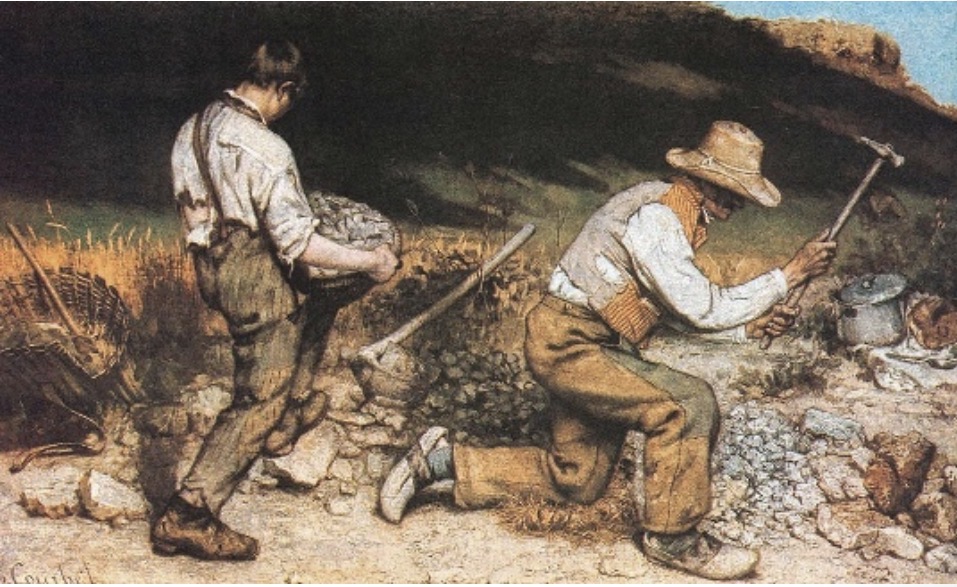
Title: The Stonebreakers
Artist: Gustave Courbet
Style/Period: Realism Period
Fact 1: This style artwork is unusual because it is such large-scale work that depicts everyday life, in this case two life-size figures working outside at the foot of the Jura Mountains, versus one that depicts historical events
Fact 2: The men are depicted pounding stones to make gravel. The strap pulling on the boy’s neck, the basket of stones resting on his knee, the falling hammer, the shadows of the hillside, and the mans trousers all create a very dense and heavy atmosphere. Leading some scholars to say that it “seems to be pulled down by the weight of physical labor.”
Fact 3: This heavy atmosphere can be associated with the heavy impression of this artwork. It shows readers the backbreaking turmoil that is passed from generation to generation. This artwork captures the true misery people felt during this time.
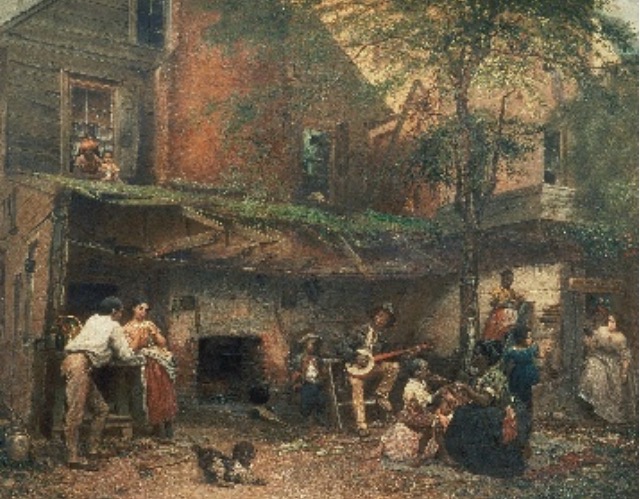
Title: Negro life in the South
Artist: Eastman Johnson
Style/Period: Realism Period
Fact 1: During this period, there was an almost romanticized view of slavery that led to a mass understanding of what the life of a slave truly entailed. One example of this is this very artwork. It shows a group of slaves gathered just chatting and listening to music. What is not pictured is the strenuous labor they more than likely just completed.
Fact 2: Johnson employed household slaves, whom his father owned, to model for this artwork. This created an intense level of realism in this artwork. This artwork sparked controversy surrounding the fact that viewers could not tell if it was for or against slavery.
Fact 3: On one hand, a banjo-picker is seen playing a song for a mother and child who are dancing, and a white mistress is seen stepping out of the house as if ready to join. This creates a feeling in viewers that the slaves are content in their situation. On the other hand, the evident difference between the gown of the mistress and the clothing the slaves are very shows a clear difference between what life was like as a slave versus someone who is not.
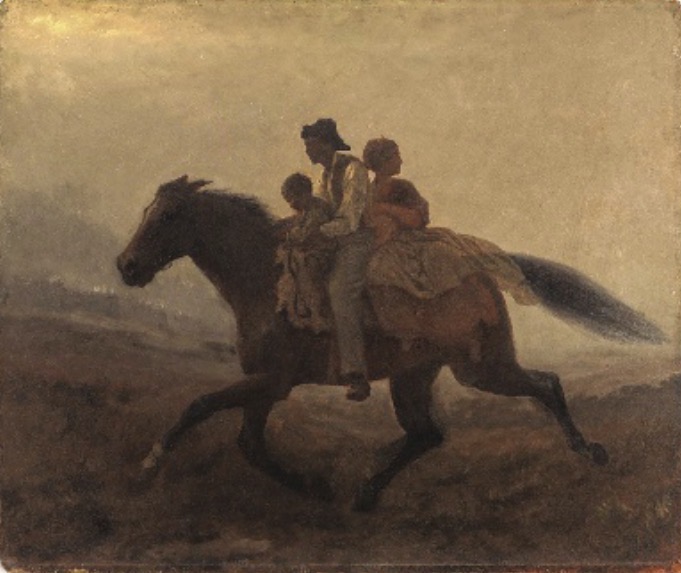
Title: The Fugitive Slaves
Artist: Eastman Johnson
Style/Period: Realism Period
Fact 1: There is a stark contrast between this work and his earlier work Negro life in the South. This artwork was inspired by an incident that he witnessed. The painting seems very light and joyful, whereas this one has a darker mood that displays fear and turmoil.
Fact 2: Some compare this scene to the description of Mary, Joseph, and the baby Jesus into Egypt. It is important to realize that there is also a small child being held in the arms of the mother. This shows how everyone, no matter what age, was affected by war and slavery.
Fact 3: Unlike, the “happy” houseslaves Johnson depicted in this first artwork, this artwork depicts a dark sky, filled with smoke. Reflections can be seen flashing off the barrels of the rifles under the muzzle of the horse. Iti is evident that this family is scared and desperate to escape the battle.
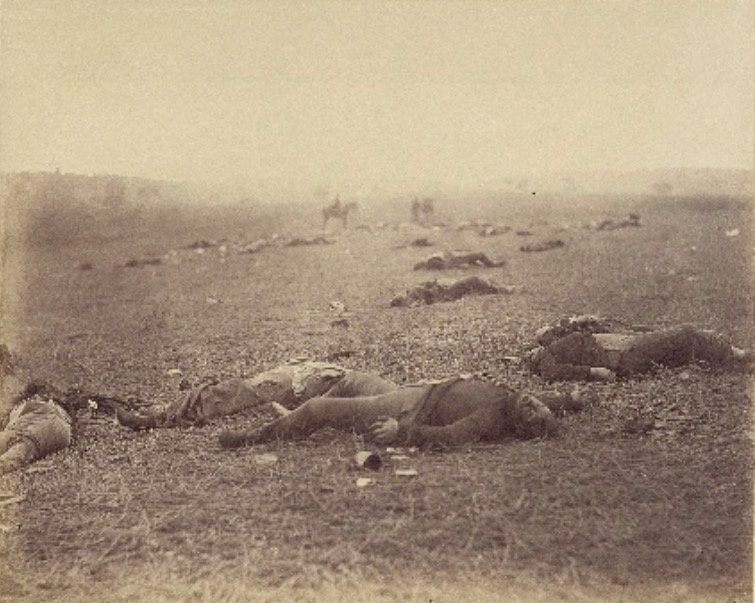
Title: A Harvest of Death
Artist: Timothy O’Sullivan and Alexander Gardner
Style/Period: Realism Period
Fact 1: Prior to the work of Gardner, no photograph had ever been taken of an American battlefield prior to the dead being properly buried. Gardner even went as far as rearranging the bodies for photographic effect.
Fact 2: Garnder and his assistant, O’Sullivan, took this photo at the site of the Battle of Gettysburg. This image became one of the most famous photographs to come out of this war.
Fact 3: Most artwork or photographs have a focal point, well in this case, it was the corpses. O’Sullivan ensured that the corpses would remain the focal point by blurring out both the foreground and background of the scene. This was possible in part to the introduction of albumen paper.
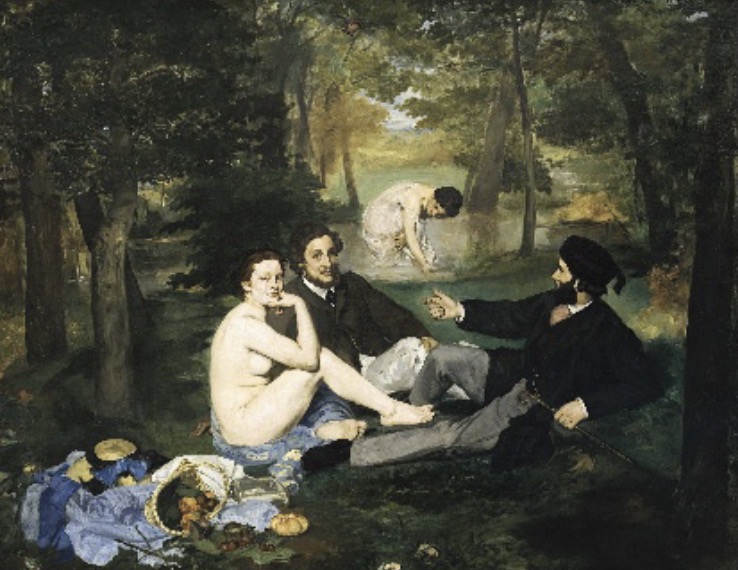
Title: Luncheon on the Grass
Artist: Edouard Manet
Style/Period: Realism Period
Fact 1: Edouard Manet was a flaneur, which was known for being a man-about-town, men of this style were commissioned during this time to create works of art that described the modern city and its culture.
Fact 2: Many of Manet’s artworks were designed with contentment towards the bourgeoise, which is the capitalist social class that owns the means of production and profits from the labour of others. This artwork seems to represent this class and there was not met with much appreciation by the jury for the Salon.
Fact 3: Although met with displeasure, it was not the intention of Manet to please that particular group of people. He’s artwork was placed in the Salon des Refusés, which had a reputation for including art of poor quality, art that challenged style and art that included scandalous content, which is a testament to how people viewed this artwork.
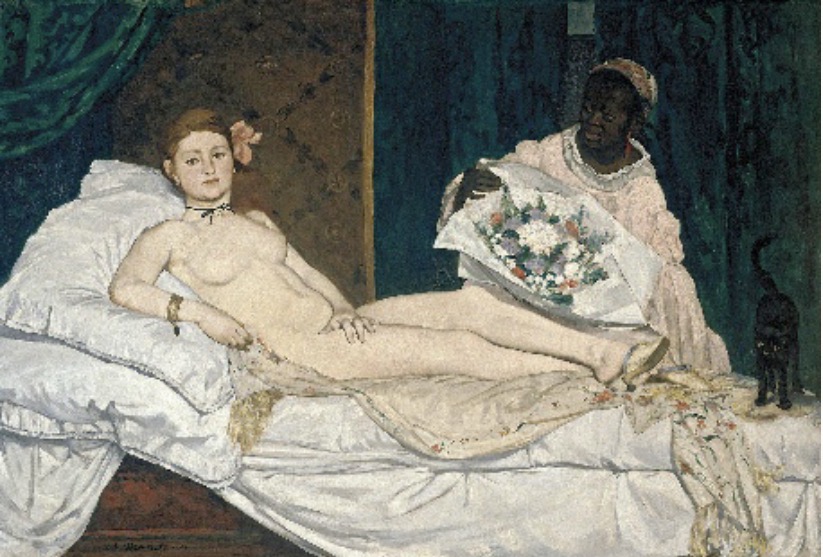
Title: Olympia
Artist: Edouard Manet
Style/Period: Realism Period
Fact 1: Different animals can be a symbol for different things in art. For instance, a dog, which can be seen at the nudes' feet in Venus of Urbino, symbolizes fidelity. In this artwork a black cat is featured. In art, a black cat often symbolizes promiscuity.
Fact 2: Artwork that featured female nudity, especially when the female is presented as directly confronting the viewer, sparked much controversy due to most viewers feeling discomfort when viewing the artwork. In response, Manet fully embraced this discomfort and positioned his nude female to directly face the viewer.
Fact 3: Some scholars believe that the woman in the artwork represents the trials that people were facing at this time. Some say that she represents a factory girl who lost her job following the civil war and has now turned to prostitution, as many women did during this time.
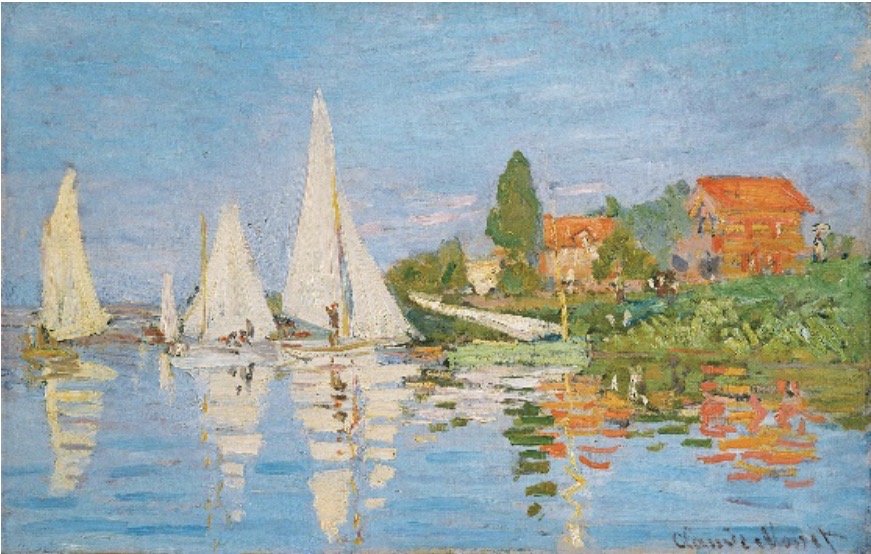
Title: The Regatta at Argenteuil
Artist: Claude Monet
Style/Period: Impressionism Period
Fact 1: This painting is a direct representation of Monet’s belief that the only way he could realize his true potential was through en plain air. This was the belief of catching lighting and movement in the moment outside, vs. in a studio. He greatly encouraged improvisation and spontaneity.
Fact 2: In the painting, it is evident the level of connection and skill Monet has by the use of combining the look of a sail, with the reflection of the red house and the green cypress trees that can be seen on the hillside.
Fact 3: This art style can be compared to that of abstract art, however it has a much clearer and more defined image. Monet says one must paint in shapes of colors versus painting exactly what is seen.
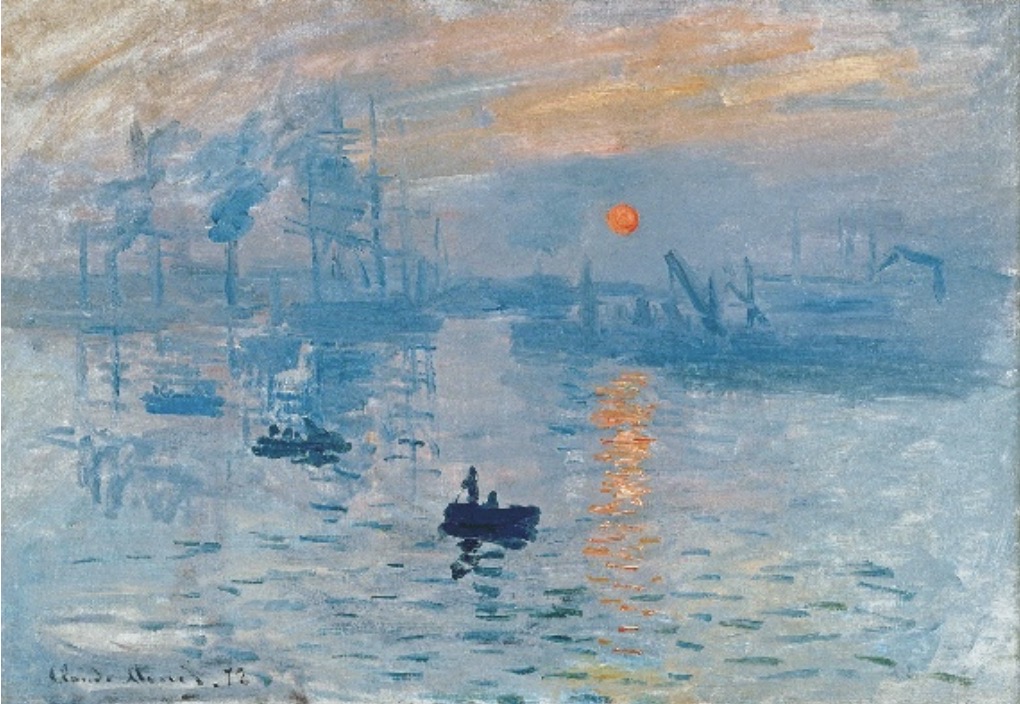
Title: Impression: Sunrise
Artist: Claude Monet
Style/Period: Impressionism Period
Fact 1: This painting is believed to have had a large part in the style of Impressionism getting its name. Monet used unmixed colors to encode forms in itself. Rather than focusing on creating an artwork that appears much like a photograph, he emphasized the look of the brushstrokes.
Fact 2: Although Monet focused primarily on en plain air painting, he did rework his paintings in a studio setting. However, he reworked his paintings in such a way that they did not lose the “of the moment” perspective and become one resembling a photograph.
Fact 3: The colors that Monet chose to use, for example, the violets and blues and yellows and oranges, helped emphasize the time in which the artwork was painted, in this case in the morning.
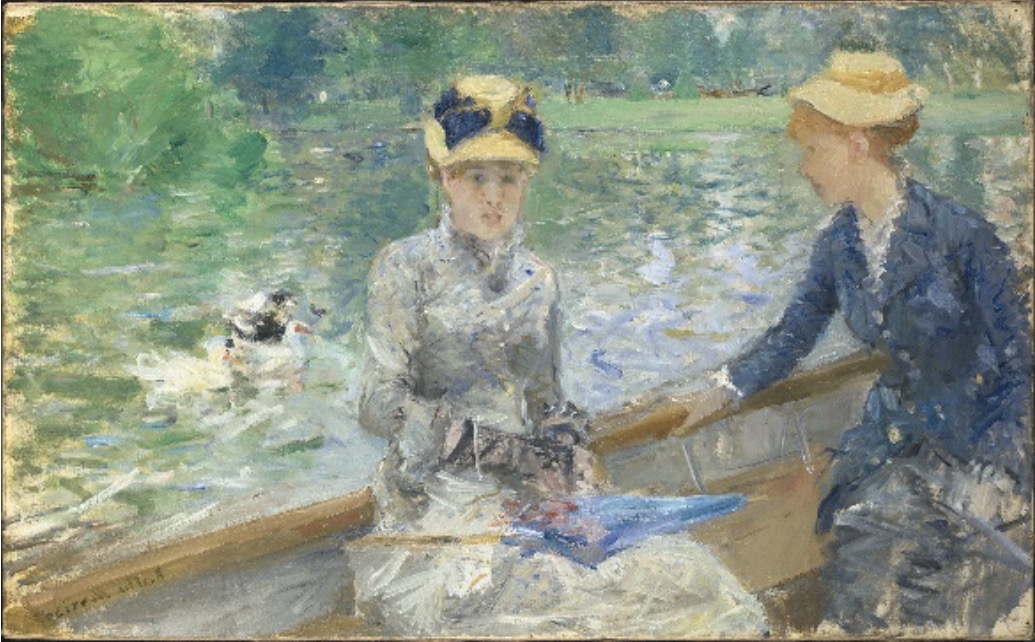
Title: Summer’s Day
Artist: Berthe Morisot
Style/Period: Impressionism Period
Fact 1: Morisot uses pattern to display distinct differences between the two women. For instance, the bottom of the woman in blue’s dress is composed of a zigzag pattern. In contrast, the bottom of the woman on the rights dress is composed of a patchwork of straight strokes.
Fact 2: Even more so than Monet, Morisot used feathery strokes of paint versus clear or extremely distinct lines. Some attribute this to the work of her grandfather, Fragonard, who was known for his rapid brushwork.
Fact 3: In stark contrast to Manet’s depiction of nude females, Morisot chose to depict the women in full dresses that almost blended in with the background of the painting. The background of the painting is barely distinguished due to its lack of clear lines and quick brush strokes.
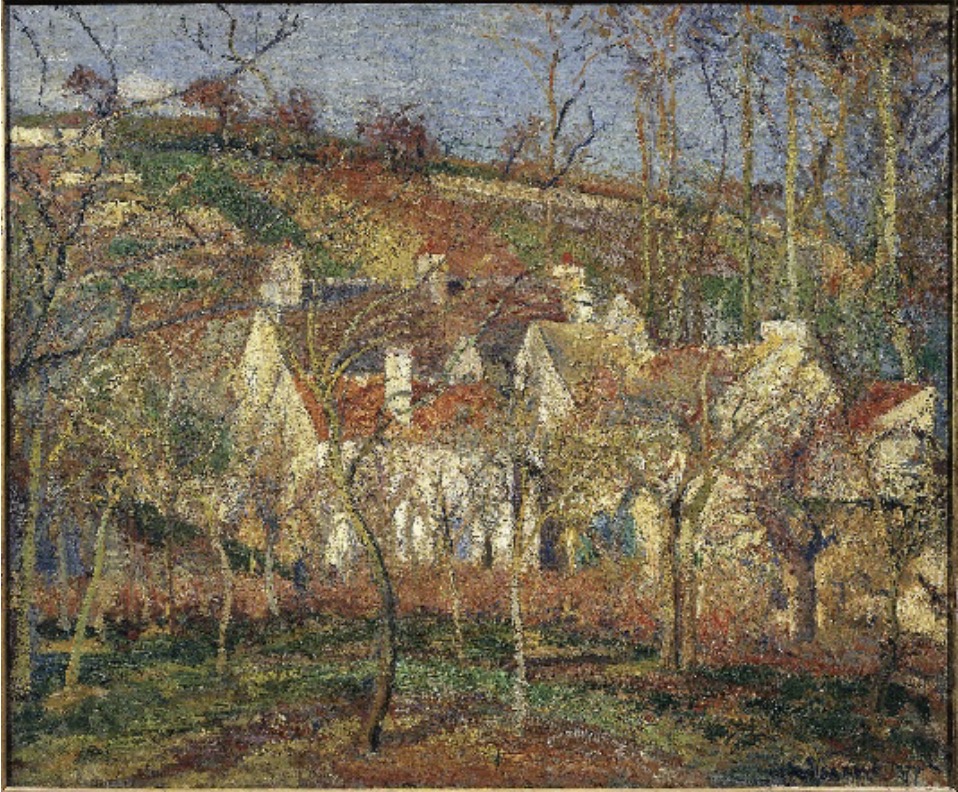
Title: Red Roofs
Artist: Camille Pissarro
Style/Period: Impressionism Period
Fact 1: Some scholars say that the veil of tress creates a barrier that leads to viewers feeling as though the landscape had not been fully captured by Pissarro. Much like Morisot, Pissarro employed the use of color to emphasize certain details in the painting.
Fact 2: Pissarro was very interested in the science of color theory, which was new during this time. This is evident through his employment of red and green, orange and blue patchwork painting that makes up the majority of the painting.
Fact 3: Viewers might note the darker color blue for the sky and the barrenness of the trees. These two “small” details help viewers realize that this painting was most likely painted near winter time.
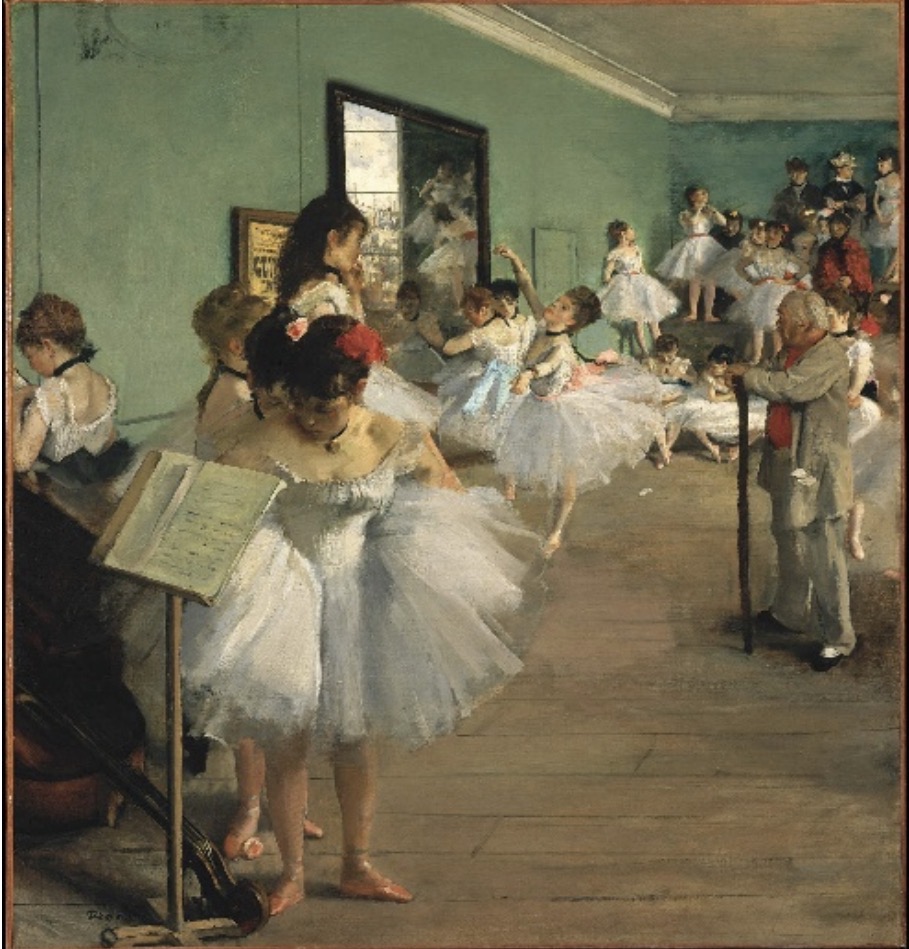
Title: Dance Class
Artist: Edgar Degas
Style/Period: Impressionism Period
Fact 1: Degas used the prestigiousness of this painting to represent not only the hard work and effort that the ballerinas put in to strive for perfection, but also the hard work and effort Degas put in to create this artwork.
Fact 2: Degas employs the use of shape to connect the foreground to the middle ground of the drawing. He does so by painting the dances in such a way that they form an arc, creating this connection.
Fact 3: The primary theme of Degas’s paintings was centered around work. The prestigious dancers, Degas’ implied effort, the instructor who appears to be injured which is evident on his reliance of a cane. The instructor especially is meant to represent someone who worked so hard, that he pushed himself to the point of injury.
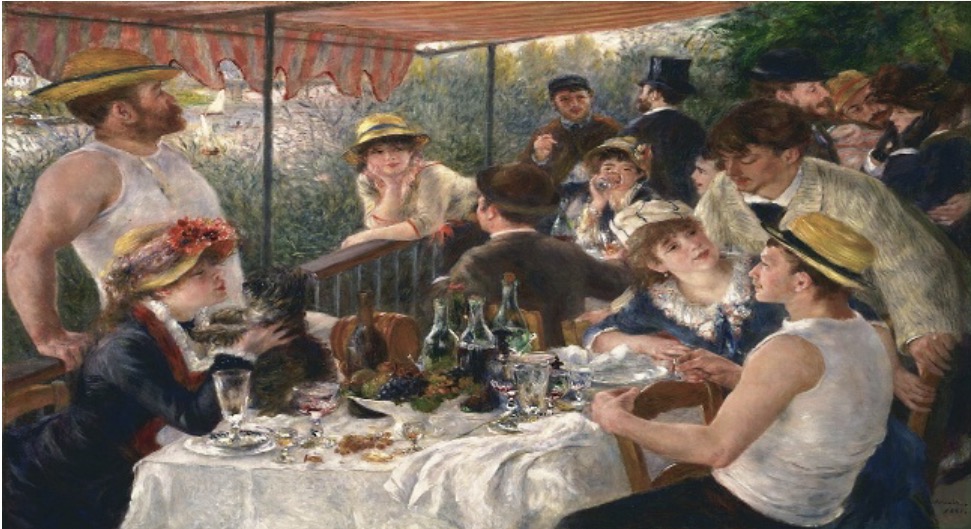
Title: Luncheon of the Boating Party
Artist: Pierre-Auguste Renoir
Style/Period: Impressionism Period
Fact 1: This setting is based on the Madison and Restaurant Fournaise, which was a house and restaurant found on an island in the river, it was said that Renoir was particularly fond of this place.
Fact 2: Many of the figures in this artwork can be identified as Renoir’s circle of friends, acquaintances and members of the Fournaise family. The Fournaise family being featured is extremely important to the fact that they own the restaurant in which this artwork is set.
Fact 3: Within the artwork there is several stories that can be tied to the people and their character can be seemed through the way in which Renoir depicted them. For instance, Baron Raoul Barbier, who is a notorious womanizer, is seen flirting with the proprietors daughters, Alphonsine Fournaise.
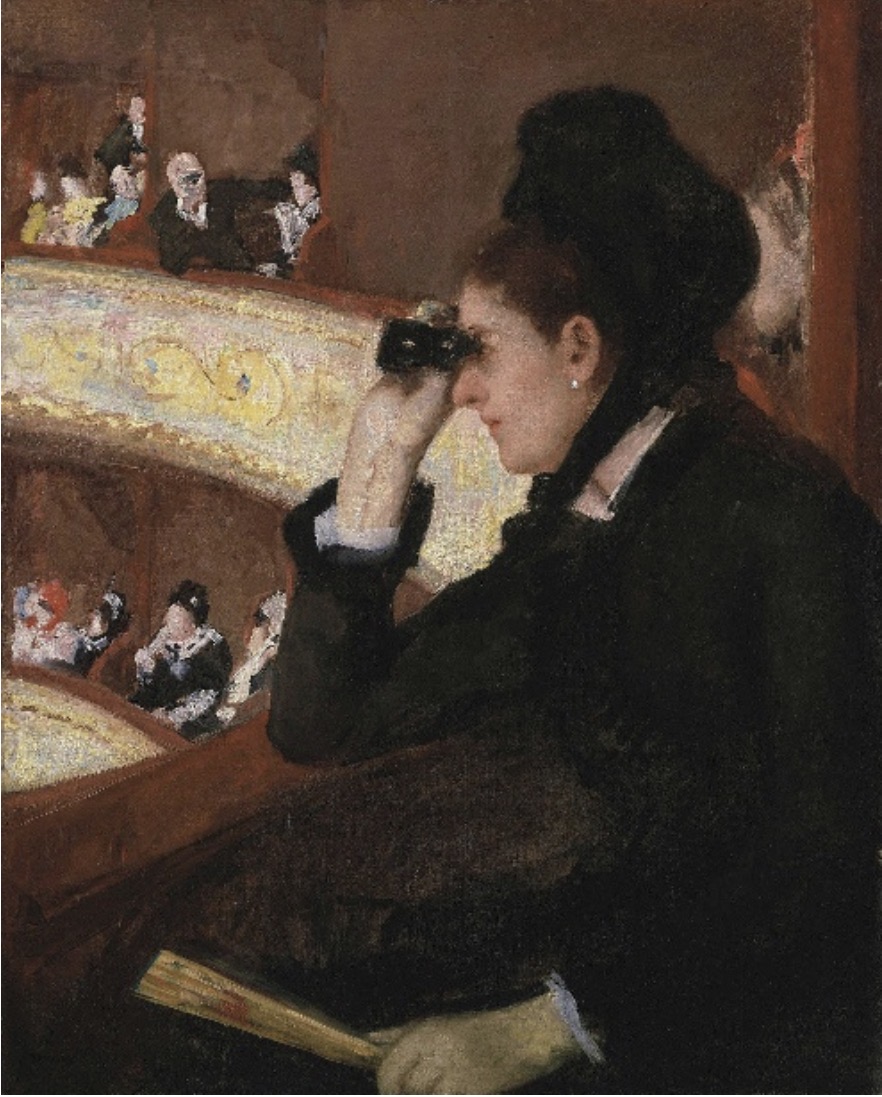
Title: In the Loge
Artist: Mary Cassatt
Style/Period: Impressionism Period
Fact 1: This picture is composed of a woman at the Paris Opera, clearly fascinated by what is happening on the stage. It also shows a man, accompanied by another woman, clearly fascinated with the main woman in this painting, as he leans in and uses his glasses to try to get a clearer view.
Fact 2: This painting is displayed in the United States, which is of significant importance because it was the first of Cassatt’s impressionist painting to be displayed in the United States. It also marked as a sort of heartbreak for Cassatt in the fact that the US called it a sketch, while she intended for it to be a finished painting.
Fact 3: The woman in the artwork is believed to represent what a modern-day woman looks like. The woman is depicted wearing a simpler black dress in which she blends in with the crowd more versus a stunning, bright ballgown as in earlier times.
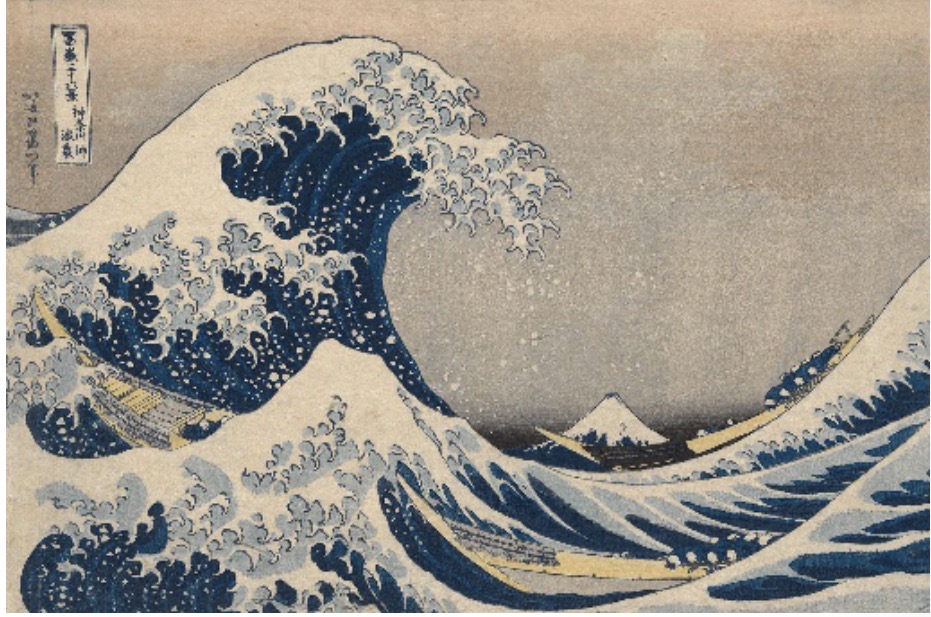
Title: The Great Wave
Artist: Katsushika Hokusai
Style/Period: Ukiyo-e Period
Fact 1: This artwork consists of three boats descending into what seems to be a trough. The wave in this photo towers over these boats in an almost menacing way. The artwork creates a feeling of suspense within viewer because the viewer is left wondering what happens next.
Fact 2: Featured in the artwork is Mount Fuji, this is significant because this Mount represents immorality and Japan itself. Also the wave is larger, viewers have a peace in knowing no matter what the wave does, the Mount wiki remain. This could be a testimony to Japan’s strength despite major problems it might face.
Fact 3: This artwork is a part of a series of prints. Prints at this time were mass produced and affordable. These prints depicted Japanese social and cultural activity. Due to them being affordable, these lessons and stories were able to be spread in a much more effective manner.
Who was considered the chief drafter of the American Declaration of Independence and chairman of the committee that prepared the document?
Thomas Jefferson
Adam Smith, author of The Wealth of Nations, asserted that a laissez-faire economic policy was best. What was Smith’s other, related, assertion?
Slavery is justified because it is inexpensive labor.
How was David’s The Oath of the Horatii relevant to his day?
The story is a parable of loyal devotion to the state.
What was the purpose or intent of David’s Napoleon Crossing the Saint-Bernard?
It served as political propaganda.
Who is the author of “Tintern Abbey”?
William Wordsworth
Landscape" derives from a similar word in which language?
Dutch
For which of the following paintings did J. M. W. Turner reportedly have sailors “lash [him] to the mast to observe” the scene?
Snow Storm—Steam-Boat off a Harbour’s Mouth
Which of the following works features a lone man with windblown hair positioned directly in front of the viewer on a rocky promontory?
The Wanderer above the Mists
What is one of the principal afflictions of the Romantic hero?
ennui
Which of Frédéric Chopin’s compositions were known as “studies,” which addressed particular technical challenges on the piano?
etudes
Who wrote an autobiography that provides a compelling account of life under slavery?
Frederick Douglass
Who is known for paintings that demonstrate his interest in the daily lives of working people, as in Rue Trasnonain?
Honoré Daumier
Which of the following describes Karl Marx’s Das Kapital?
It offered a view of the conditions of the proletariat and an interpretation of capitalism.
What was Édouard Manet’s motivation in creating large-scale, controversial works?
He was considered a flâneur, someone determined to shock a bourgeois audience.
Who shot the photograph A Harvest of Death, Gettysburg, Pa., considered by some as “the most famous photograph” to come out of the American Civil War?
Timothy O'Sullivan
What did Napoleon III commission Baron Georges-Eugène Haussmann to do?
modernize Paris
What is the French phrase for painting done out of doors?
en plein air
Who was interested in color theory and painted Red Roofs, which the author describes as a “random patchwork of red and green, orange and blue [that] appears through a veil of tree branches that interrupt the viewer’s vision”?
Camille Pissarro
Which of the following works includes this line: “Whoso would be a man must be a nonconformist”?
"Self-Reliance"
What name do the Japanese use to refer to the art of woodblock printing?
ukiyo-e
Robert Walton is
an adventurer and sea captain
Who is the first victim to be killed by the creature?
William
Victor's interest in science is initially inspired by his youthful reading of
the works of Cornelius Agrippa
Elizabeth Lavenza is
a cousin of Victor's adopted by the Frankensteins
Where does Walton find Victor Frankenstein?
on a piece of ice floating in the ocean
Ultimately, Victor's schooling results in his being obsessed with
knowledge
Walton's goal is to
find a new passage between the Atlantic and the Pacific
To whom does Walton address his letters?
Margaret Seville
After Victor's creature comes alive, Victor looks at him and is horrified and disgusted.
True
In Mary Shelley's novel, the name "Frankenstein" is given to the monster that is created by Victor.
False
What does the Creature want Victor to do?
create a female to be his companion
How does the Creature learn to speak?
by listening to Felix teach Safie the German language
Victor's not protecting his wife from the Creature on his wedding night could be explained by noting that he
is in denial about everything.
Where does Victor listen to the Creature's account of himself and his demand upon Victor?
in a hut on a glacier near Montanvert.
Walton is the first narrator in Frankenstein. Who are the other two?
Victor and the Creature.
At the end of Frankenstein, who says this: "But soon I shall die, and what I now feel be no longer felt. Soon these burning miseries will be extinct. I shall ascend my funeral pile triumphantly, and exult in the agony of the torturing flames"?
the Creature
How old was Mary Shelley when she wrote Frankenstein?
18
Victor's greatest sin is
abandoning the Creature.
Why is Justine accused of murder?
the picture of Caroline was found in her dress
What is the subtitle of Frankenstein?
"Or, The Modern Prometheus"
Compare and contrast the French and American Revolutions.
The American Revolution can be described as revolt by the upper-class, colonial elites, middle-class against a king that they felt deprived them of rights and privileges. This revolution was centered around a list of grievances. It was a fight for freedom, control, power, and democracy. The French Revolution can be described as a revolt against an absolute monarch who abused the power of his position. Unlike the American Revolution, all classes of people led this revolt including the poor and peasants as well. Both revolutions and what they stood for were used as models when forming their next versions of society. Both revolutions were inspired by Enlightenment principles.
Describe the Neoclassical style and explain why this style, in particular, emerged following a period marked by revolutions. Provide an example of a Neoclassical artifact in your response.
The Neoclassical style was popular during the late eighteenth to mid nineteenth century, especially in Europe and the United States. It consisted of art styles like those found in classical Greek and Roman forms regarding the ideals of civic virtue and heroism. The Oath of the Horatii and Napoleon Crossing the Saint-Bernard are both examples of art from the Neoclassical period. These artworks were often used to express ideals of democracy and political propaganda. In the case of Napoleon Crossing the Saint-Bernard, it was used to glorify Napoleon’s leadership. The fact that Napoleon did not actually lead the crossing is representative that these artworks were designed to make revolutionists, therefore revolution, more so than being historically accurate.
Compare Ingres’ La Grande Odalisque to Delacroix’s Odalisque and provide a discussion of differences in style, making sure to identify the style that each artist is using. How is the same subject markedly different in each composition. What is an odalisque, anyway?
The La Grande Odalisque was created during the Romanticism Period by Jean Auguste-Dominique Ingres. The Odalisque was also created during the Romanticism Period by Eugene Delacroix. An odalisque was a name given to a female slave or concubine in a Middle Eastern harem. Delacroix used deeps reds to create a sense of intense eroticism. He also positioned the model in such a way that she was open to the viewer. In contrast, Ingres used cool tones to create a sense of sexual aloofness. He posed the model in such a way that she was more closed off to the viewer. Ingres also focused more on the demanding curve of the backdrop in his artwork vs the proportionality of the model.
Define Romanticism as it manifests itself in both literature and painting.
Romanticism was a movement that highlights emotion and the psychological complexity of art. It also focuses on an individual’s relationship with nature. This movement was marked almost directly opposite from the Neoclassical period which focused on an individual’s relationship to the state, balance, and simplicity. It focused on diving into emotion to find one’s inner goals and feelings. The psychological side of this art style is evident through the painting Saturn Devouring One of His Children. This artwork depicts the internal and mental battle that Goya was facing. Frankenstein is an example of Romantic literature. The ideal of romanticism is evident in this post in regard to the psychological battle Victor faced when choosing between loving and abandoning the creature.
In many ways the Romantic Movement is considered a response to the rationality of the Enlightenment. Explain this statement.
The Romantic movement highlighted emotion, psychological complexity, nature, and individuality. The Enlightenment movement highlighted reason, science, and logic. Some people consider these ideals to be complete opposites. Romanticists felt as though Enlightenment followers focused too heavily on these ideals and in turn, the romantic movement was created. The effect that the Revolutions had on people can be seen as a tribute to the dramatic shift towards romanticism.
The mythological subject of Prometheus becomes the symbol for the Romantic Hero. What is the story of Prometheus and how does this story represent a darker understanding of the romantic period. What are other examples (in painting and in literature) of this dark romantic hero? Be sure to give specific references to works covered in the class and explain their use of this character.
Prometheus was a Greek Titan known for stealing fire from Mount Olympus to give to humanity and because of that he finished a severe punishment by Zeus. This punishment consisted of Prometheus being chained to a rock in which a bird would eat his liver every day and it would grow back at night. It represents a story of sacrifice, rebellion, and the pursuit of knowledge at any cost. Victor in the novel Frankenstein is an example of a dark romantic hero. He wanted to pursue greater scientific knowledge to the point that he disregarded all sense of morals, even more so when he abandoned the creature. Saturn Devouring His Son is an example of a dark romantic hero as well. Saturn was seen as the god of prosperity and harvest, however there is an evident shift in this artwork which depicts him devouring his own child, thus killing prosperity and in a way the harvest. This shows Goya’s inner turmoil as a result of diving too deep into his emotions.
What is a flâneur? Knowing that Manet considered himself to be a flâneur , what do you think were his intentions in presenting Le Déjuner sur l’herbe to the jury for the Salon of 1863?
A flaneur can be defined as someone who aimlessly walks around town detached from present society. These types of people were believed to stroll the city with no apparent occupation, just studying their surroundings. It is possible that his intentions were simply to raise awareness of the materialistic lifestyle, that many bourgeois valued, which he greatly despised. He did not present this painting as a tribute to the Salon, but as a mockery to the culture that the Salon draws in. His inclusion of nude figures and the challenging ideals he presented led to his artwork being placed in the Salon des Refuses, which was known for presenting artwork of this kind.
Discuss the rise of photography as an artistic medium. How did photography change the arts?
The rise of photography hit its peak mainly because of the wars. Photography was a remarkable growth in both science and art. Although art had its technical limitations, it brought a sense of realism other forms of art simply weren’t able to obtain. For instance, the photograph A Harvest of Death, Gettysburg, Pennsylvania brought to reality the horror and tragedy of war that, prior to these images, some people didn’t understand the severity of.
Discuss several ways in which Henry David Thoreau proved himself to be a nonconformist.
To understand what is not, one most first understand what is. A conformist is known as someone who adheres to the norms, rules, or standards of society that are deemed to be acceptable. Thoreau, in most cases, refused to do some things simply because it was socially acceptable too. For instance, his unwillingness to conform to the expectations of the school system in regard to inflicting corporal punishment, led to him leaving his first job. Although slavery at this time was deemed a social norm, he went as far as accepting jail time due to his unwillingness to conform and pay taxes to a government that supported slavery, a concept he didn’t agree with.
What is the difference between Classical and Romantic music? Provide examples of each.
Classical music can be described as a alternative to Rococo and Baroque styles. It is centered around the ideals of proportion, balance, unity and clarity. Mozart’s Symphony No. 40 is an example of classical music. It is known for its almost perfect balance and control, which were key concepts during the classical period. Arguably one of the best-known examples of classical music is Beethoven’s Symphony No. 5. This work is special, it not only is an example of classical music, but marks a transition into the Romantic era style of music. The Romantic musical style was more so centered around the concept of evoking feelings and emotions, especially of struggle and triumph. One of Beethoven’s first expressions of the Romantic style can be found in his Third Symphony, the Eroica.
What is “the sublime”? Provide an example from art.
The “sublime” can be explained through the quote, “The machinery of awe, of fear, of terror, or pain” that is evoked. It is an experience that viewers or listeners obtain through a work of art. For instance, the Monk by the Sea by Caspar David Friedrich, depicts how truly small humans are in regard to nature and God’s plans. It instils a sense of doubt or even fears as the man in seen staring into what feels like a void, engulfed in emptiness.
Define Impressionism and examine how it transformed conventional assumptions about style and content in painting.
Impressionism can be defined as art that focuses on capturing light, atmosphere, spontaneous brushwork, and scenes from everyday life. It focused on the feeling one might get when viewing a scene vs, the depiction of the actual scene itself. This is a big shift from the movement of realism in which everything was meant to resemble the scene in its entirety in such a way that the viewer feels like they are viewing the scene firsthand.
As the nineteenth century became the era of identity and nationality, how did artists and writers bring attention to the working classes? Provide examples.
Artists and writers brought attention to the working class by depicting them doing everyday jobs and duties. For instance, in the artwork The Stonebreakers, by Gustave Courbet, Courbet depicts two men of different generations doing intense labor. This depiction brings attention to the working class who build the roads which people use today, as well as a symbol of growth and expansion. This depiction of hard work and manual labor contrasts with works such as Negro life in the South, in which Johnson focused primarily on the rest periods of slaves in which they are dancing and laughing versus when they are working tirelessly. Depictions such as these, that make life in America and the identity in which it claims to be the “land of the free” seem far greater than what Americans were truly experiences were evident in literary works such as Uncle Tom’s Cabin as well.